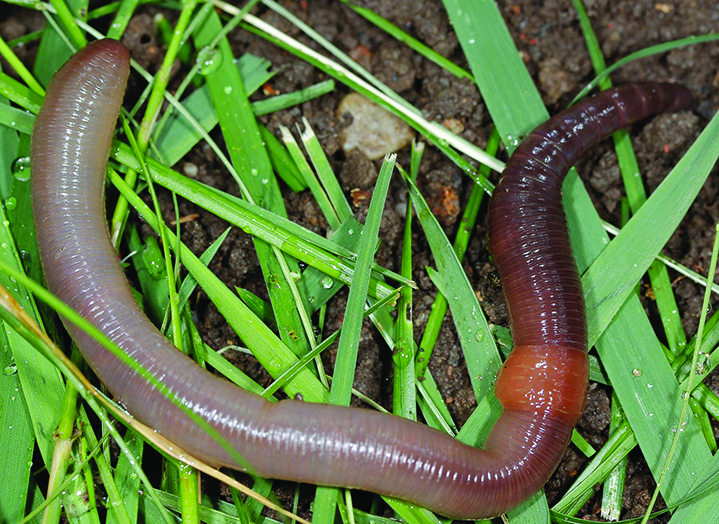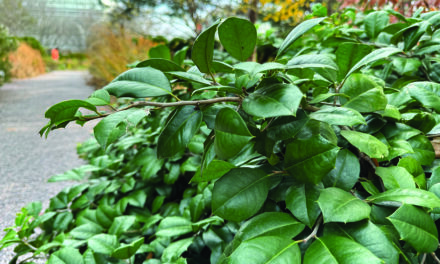
While not native to the United States, European earthworms can alter soil structure but not as quickly or as extensively as Asian jumping worms. (Photo courtesy Forestry Images)
Not all worms are created equal. Gardeners typically consider worms “the best thing you can do for your soils.”
But that is not true, asserts Ryan Hueffmeier, director of the Boulder Lake Environmental Learning Center in Minnesota.
He was the speaker in a recent Zoom presentation sponsored by the North American Invasive Species Management Association.
The topic was “Non-native Invasive Earthworms 101: From the Nightcrawler to the Jumping Worm.”
Most earthworms in the Mid-Atlantic region are non-native, Hueffmeier said.
“Since their introduction they have been documented causing negative environmental impacts — altering the soil profile by the way they feed and burrow and altering nutrient cycling by their consumption of organic matter.”
In a quick history lesson, Hueffmeier explained why that nutrient cycling is not good when it happens too fast, as it does with so-called jumping worms introduced to the United States from Asia.
Eighteen thousand years ago, glaciers reached as far south as New Jersey and Pennsylvania.
There was permafrost, so any native earthworms would have been killed, Hueffmeier said.
On top of bedrock, there was the slow build-up of the soils we have now. Fungus and bacteria were the recyclers.
It happened slowly. Earthworms break down organic matter faster.
Earthworms and their eggs hitchhiked across the Atlantic in plants brought by Europeans.
Dirt and rocks used as ship ballast also included worms.
Earthworms were introduced in the eastern United States and made their way west.
“It is rare to find an earthworm-free area,” Hueffmeier said.
Originally from Korea and Japan, jumping worms, Amynthas agrestis, are asexual, maturing in 60 days, and can lay eggs in cocoons every other day.
In some places, 300 individuals have been documented within a square meter.
Jumping worms live only one year, dying in the fall.
Nightcrawlers, by contrast, require 130 to 150 days to mature, need a mate, and live more than one year.
“Jumping worms alter the soil structure and chemistry,” Hueffmeier said. “They turn the top 3 to 5 inches into nothing but castings. Slopes are like sand dunes — you walk on them and slide.”
Nutrients are concentrated in the top few inches and get flushed out because plants can’t take them up fast enough, he added.
Jumping worms can eat woody material such as wood mulch. They also eat the ends of roots, leaving stubs.
Mature jumping worms average 4 to 6 inches in length, with some reaching up to 8 inches.
Their head and tail are remarkably more streamlined than European worms, pointed at both ends.
The light-colored ring around the worm call the clitellum is closer to the head and encircles the whole body evenly. Milky white, it is barely raised above the skin and is thinner than a European worm’s.
The latter has a clitellum that is puffy on top and flat on the bottom.
“The jumping worm’s ring starts at 15 segments. The nightcrawler’s is 20 to 30 segments back,” Hueffmeier said.
Another difference is the spacing of setae, the tiny hairs worms use to move.
You may need a magnifying glass to see that the jumping worm has eight bristle-like hairs per segment, evenly spaced around the entire segment. European worms have paired setae.
Jumping worms are very active, thrashing about more like a snake when agitated.
This makes them unsuitable for fishing worms. When disturbed, they secrete yellow mucus.
While all these traits are important for identification, jumping worms start in the spring as newly hatched babies from eggs laid in the fall.
What you will notice first, Hueffmeier said, is the unique soil structure they create.
Are jumping worms on the Delmarva Peninsula? In 2018, the Delaware Invasive Species Council highlighted Amynthas spp. as its “Invasive Species of the Day” (or genus, in this case).
Hueffmeier’s advice, if you have jumping worms:
• Don’t panic;
• Take precautions to avoid spreading. Wherever you move the material they are in, the worms go;
• As you see them, remove and destroy them by putting them in a plastic bag and throwing it in the trash. Chickens and reptiles love them;
• Experiment. Try a variety of plants or consider alternative landscaping. Keep a log and share successes. See how the plants impact the worms;
• Spread the word. Once you understand how to identify them, it’s easy. There is self-guided training you can do;
• Share with everyone a warning not to buy jumping worms. They are not good composting worms;
• Don’t move invasive species;
• Anglers should dispose of unwanted bait worms in the trash;
• Gardeners should be on the lookout in soil, potted plants, mulch or compost; and
• Vermicomposters should learn how to identify worms. In a study six years ago, Hueffmeier said composting worms were ordered from various sources. A lot of them were mixed with jumping worms or were all jumping worms.
Judy Pfiester, a Delaware Master Gardener who teaches workshops on vermiculture said, “I always advise clients to ask for Eisenia fetida when
ordering composting worms. If the seller doesn’t know the scientific or Latin name, go somewhere else to purchase them.”
Hueffmeier’s presentation is able to be viewed at https://www.youtube.com/watch?v=NNqOzIVvHFg.




